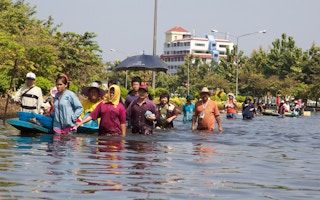The increasing threat from climate change has made coastal cities more vulnerable to floods, which impacts could be further exacerbated by extreme weather events. In the next three decades, rising sea levels will severely affect low-lying Asian countries, such as Vietnam, Indonesia, the Philippines and Thailand. As a result, an estimated 300 million people living in these sinking cities will be affected by floods in 2050. While developed countries generally have better mitigation and adaptation strategies to deal with the problem, developing countries, such as those in Southeast Asia, are often left out due to the lack of financing, policy frameworks and technological know-how.
There is a relationship between economic growth and the growth of urban areas. In many countries, export-oriented growth corresponds to the expansion of urban areas near coastal ports. These coastal cities are prone to the adverse impact of climate and environmental change. The Intergovernmental Panel on Climate Change (IPCC) reported that over the last 100 years, the mean global sea level has risen by an average of 1 to 2 centimetres per year. The IPCC also acknowledged that sea level rise could be influenced by human activities, such as subsidence and coastal development.
The policy responses to the ‘sinking cities’ problem in Southeast Asia are mostly infrastructural, dating back to the colonial era. Governments often approach the problem by building dikes, seawalls and by reclaiming land. Such infrastructural solutions are more appealing to the public, as they provide a sense of security and protection from floods. In addition, some infrastructural solutions to address floods are financially more attractive than some nature-based solutions that could provide flood protection while addressing climate change. These include the National Capital Integrated Coastal Development in Indonesia and the Manila Bay Integrated Flood Control, Coastal Defence, and Express Way project in the Philippines. However, these infrastructural solutions do not yield a long-term result as they only address the symptoms but not the root causes.
When these infrastructural protections fail, coastal communities often have to abandon their homes or adapt to the changing landscape. For instance, communities in Manila Bay in the Philippines and Northern Jakarta in Indonesia have been adapting to drastic landscape changes due to sea level rise and land subsidence. Although some of these infrastructural solutions have failed to protect these communities from inundation, policymakers do not appear to be changing their approach. Why is that the case?
A Super Wicked Problem
The ‘sinking cities’ problem is a ‘super wicked problem’. Scholars use this term to characterise problems that meet four criteria: the lack of time, when those seeking to solve the problem are also its source, the lack of a central authority (or a weak one), and policies that reduce the impact of the future irrationally.
As a super wicked problem, sinking cities are a ticking time bomb, as land continues to subside, while climate extremes become more frequent. Once the land sinks, there is little which can be done to reverse the situation. Besides, the infrastructural solutions often result in a boomerang effect. For instance, while the large-scale seawalls provide immediate protection from inundation, their hefty construction materials add pressure to the already sinking land.
From a governance perspective, the multiple causes of sinking cities make it difficult to pinpoint a specific central actor that can address its root causes. Solving climate-induced sea level rise and land subsidence involves various stakeholders, from those responsible for coordinating climate mitigation to those managing groundwater use and urban water services. But policymakers tend to work in silos, causing unsynchronised policy measures focused on short-term returns, such as those offered by the infrastructural solutions. Besides, prioritising environmental protection over economic development has always been a difficult choice for policymakers.
Leveraging Path Dependency
Solving a ‘super wicked problem’ requires prioritisation to target the root causes more holistically. For the sinking cities problem, prioritisation acknowledges the limited time to correct the situation and the irreversibility once the damage is done.
As mentioned, the policy responses to address sinking cities in Southeast Asia tend to follow infrastructural path dependence: building protective infrastructure that have been conveniently pursued since the problem started to appear. Rather than antagonising path dependency, policymakers should learn from it to prescribe policy solutions that could trigger what is called ‘progressive incrementalism’, a process that relies on smaller, evolutionary steps.
“
As a super wicked problem, sinking cities are a ticking time bomb, as land continues to subside, while climate extremes become more frequent. Once the land sinks, there is little which can be done to reverse the situation.
Two points need to be ensured to create a path-dependent effect. First, at the governance level, appointing a central stakeholder to oversee and consolidate efforts to address the sinking cities issue could be a good initial step. This will help identify the gaps and conflicting measures done by different actors and synchronise the efforts to make them more holistic. Political will, thus, is the key to ensuring that there is a centralised governing stakeholder responsible for resolving the silo mentality that hinders the holistic problem solving approaches.
Second, at the policy level, the prescribed solutions should be able to address the root causes of the problem, such as improving the registration and monitoring of groundwater extraction and expanding green spaces in urban areas. The mega-infrastructural solutions chosen by the policymakers in Indonesia and the Philippines, for instance, are focused on treating the symptoms than addressing the root causes of their sinking cities: climate crisis, excessive groundwater extraction, and poor urban planning.
In designing and implementing these policies, policymakers should mainstream human rights perspectives through affirmative actions. This will ensure that vulnerable and marginalised groups — such as urban slum residents, people experiencing homelessness, and the low-income communities — can get access to fundamental rights, such as clean water and housing.
There is, however, no universal policy prescription to address the ‘sinking cities’ problem, as the solutions will depend on the specific governance and technical contexts. Ensuring the proper application of the aforementioned points will help create incremental changes to solve the sinking cities problem while leaving no one behind.
Dimas Fauzi is Research Associate, Stockholm Environment Institute (SEI) Asia.
This article was first published by ISEAS – Yusof Ishak Institute as a Fulcrum commentary.









